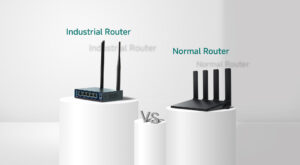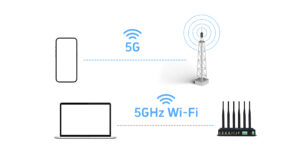What is a SCADA Cellular Modem?
A SCADA cellular modem is a specialized communication device designed for remote monitoring and control in industrial SCADA (Supervisory Control and Data Acquisition) systems. It enables wireless data transmission over cellular networks such as 4G LTE, 5G, and NB-IoT, ensuring seamless connectivity for industrial equipment in remote or hard-to-reach locations.
Core Functions of a SCADA Cellular Modem:
- Wireless Connectivity: Provides wide-area network (WWAN) access via 4G, 5G, or NB-IoT for uninterrupted data communication.
- Protocol Conversion: Converts industrial data from serial interfaces (RS-232/RS-485) and Ethernet into IP packets for transmission.
- Remote Data Transmission: Facilitates long-distance communication in environments lacking wired or Wi-Fi networks.
Why SCADA Systems Need Cellular Modems
SCADA systems are widely used in industries such as oil and gas, power grids, water treatment, and manufacturing to monitor and control critical infrastructure. Since many SCADA applications operate in remote locations, cellular modems provide a reliable, wireless solution for real-time data transfer.
SCADA System Requirements for Cellular Modems:
| SCADA Feature | Cellular Modem Requirement |
|---|---|
| Remote Monitoring | Wide-area 4G/5G/NB-IoT network support |
| Low Latency | 5G uRLLC or LTE Cat 1 for fast response times |
| High Availability | Dual SIM redundancy, out-of-network caching, auto-recovery |
| Harsh Environments | -40°C~75°C operation, IP65-rated protection |
| Cybersecurity | VPN (IPsec/OpenVPN), TLS 1.3 encryption |
| SCADA Protocol Support | Modbus TCP, DNP3, IEC 60870-5-104 |
| Low Power Consumption | PSM/eDRX support for battery-powered devices |
Choosing the Right Cellular Modem for SCADA Applications
When selecting a cellular modem for SCADA, it is essential to consider industrial-grade reliability, security, and protocol compatibility. Here are the key features to look for:
1. Industrial-Grade Hardware
- Wide Temperature Range: -40°C to +75°C operation for extreme environments.
- Electromagnetic Interference Protection: Compliance with EN 61000-6-2 industrial EMC standards.
- Rugged Design: Shockproof, dustproof, waterproof (IP65-rated or higher).
2. Reliable Communication
- Dual SIM Redundancy: Automatically switches between operators for uninterrupted connectivity.
- Data Caching & Auto-Recovery: Stores data locally during network downtime and auto-uploads upon reconnection.
- Heartbeat Detection: Ensures persistent connection by auto-recovering dead connections.
3. SCADA Protocol Support
- Compatible with Industrial Protocols: Supports Modbus RTU/TCP, DNP3, IEC 104.
- Multi-Interface Support: Includes RS-232, RS-485, Ethernet, and DI/DO connections.
4. Advanced Network Security
- Encrypted Communication: TLS 1.3, IPsec VPN to protect data integrity.
- Firewall & Access Control: Features whitelisting, port filtering, and secure authentication.
5. Energy Efficiency for Remote Sites
- Ultra-Low Power Mode: Supports Power Save Mode (PSM) for battery-powered applications.
- Wide Voltage Input: Compatible with solar power (12-24V DC) setups for off-grid operation.
Common SCADA Applications for Cellular Modems
SCADA cellular modems are widely used in various industrial automation and monitoring applications, ensuring stable data transmission over long distances.
Typical Use Cases & Requirements
| Application | Key Cellular Modem Requirements |
| Smart Grid (Meter Reading) | Low power consumption, wide-area coverage |
| Oil & Gas Pipeline Monitoring | Explosion-proof, dual SIM redundancy |
| Water Treatment Remote Monitoring | Waterproof design, Modbus RTU support |
| Mobile Asset Tracking | High bandwidth, low latency |
Conclusion
A SCADA cellular modem is an essential component for industrial automation, enabling secure, reliable, and real-time communication in remote locations. When selecting a modem, businesses should prioritize industrial durability, network reliability, SCADA protocol compatibility, and cybersecurity features to ensure seamless operations.


